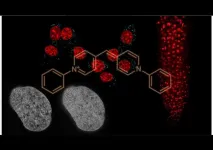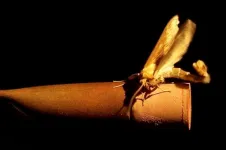Less wastage during production of marble slabs in the Roman imperial period than today
Analysis of wall decoration dating to the second century A.D. provides new insights into marble extraction and processing
2021-05-14
(Press-News.org) When it comes to ancient Roman imperial architecture, most people usually have a mental image of white marble statues, columns, or slabs. While it is true that many buildings and squares at that time were decorated with marble, it was frequently not white but colored marble that was employed, such as the green-veined Cipollino Verde, which was extracted on the Greek island of Euboea. Because marble was very expensive, it was often placed in thin slabs as a cladding over other, cheaper stones. "To date, however, no actual remains of marble workshops from the Roman imperial era have been found, so little is known about marble processing during this period," said Professor Cees Passchier of the Institute of Geosciences at Johannes Gutenberg University Mainz (JGU). Together with other researchers based in Mainz, Turkey, and Canada, he has now finished analyzing the marble cladding of a second century A.D. Roman villa. As the researchers detail in the online edition of the Journal of Archaeological Science: Reports, they utilized special software normally used for the 3D modeling of geological structures. They discovered that the material loss during marble slab production at the time was likely lower than it is today.
The researchers examined, photographed, and measured 54 restored slabs of Cipollino Verde, each measuring around 1.3 square meters, which had been used to decorate the walls of a villa in ancient Ephesus on the west coast of Turkey. In view of the saw marks on one of the slabs, they were able to infer that these slabs had been cut in a water-powered sawmill, in effect using what we today know as hydraulic metal saws. Using reconstructions based on the slab patterns, the research team was also able to conclude that a total of 40 slabs had been sawn from a single marble block weighing three to four tons. They had been subsequently mounted on the walls in the order in which they were produced and arranged in book-matched pairs side by side, producing a symmetrical pattern. Finally, with the help of the software, the researchers created a three-dimensional model of the marble block, which in turn enabled them to draw conclusions about the material wastage during the production of the slabs. "The slabs are about 16 millimeters thick and the gaps between them, caused by sawing and subsequent polishing, are about 8 millimeters wide. This material loss attributable to production equates to around one third and is therefore less than the rates now commonly associated with many forms of modern marble production," Passchier pointed out. "We can therefore conclude that marble extraction during the imperial period was remarkably efficient."
The researchers also found that although 42 slabs had been sawn from one original marble block, two had not been fixed to the walls of the hall. "The arrangement of the slabs on the villa walls suggests these slabs were most likely broken, possibly during polishing or their subsequent transportation," added Passchier. "This would mean that the amount lost due to breakage would be 5 percent, which would also be an astonishingly low figure." This small loss leads Passchier to assume that the entire marble block had been transported to Ephesus and that the slabs were then cut and polished there.
INFORMATION:
[Attachments] See images for this press release:

ELSE PRESS RELEASES FROM THIS DATE:
2021-05-14
An international research team analyzed a database of more than 1000 supernova explosions and found that models for the expansion of the Universe best match the data when a new time dependent variation is introduced. If proven correct with future, higher-quality data from the Subaru Telescope and other observatories, these results could indicate still unknown physics working on the cosmic scale.
Edwin Hubble's observations over 90 years ago showing the expansion of the Universe remain a cornerstone of modern astrophysics. But when you get into the details ...
2021-05-14
A group of scientists at Nagoya University, Japan, have developed an incredibly versatile DNA fluorescent dye, named 'Kakshine' after a former NU student of its members, Dr Kakishi Uno, but it also means to make the nucleus shine brightly, since the nucleus is pronounced 'Kaku' in Japanese. Dr Uno, with Dr Yoshikatsu Sato and Nagisa Sugimoto, the other two members of the research team at the Institute of Transformative Bio-Molecules (ITbM), succeeded in developing a DNA binding fluorescent dye with the pyrido cyanine backbone, which satisfied the three principal qualities required of such a dye - that it have high selectivity for DNA, ability to use visible light with limited phototoxicity, ...
2021-05-14
A new method to analyse the blood thinning drug Heparin has been developed that can pinpoint contaminants more accurately and quickly, providing greater quality control and safety.
An interdisciplinary team from the University of Nottingham's Schools of Pharmacy and Medicine have used the latest chemical imaging technology to identify contaminants in Heparin at the nanoscale, a discovery that manufacturers could use to improve the quality and safety of this widely used anticoagulant drug. The research has been published in Communications Chemistry.
Heparin is naturally occurring glycosaminoglycan ...
2021-05-14
ATS 2021, New York, NY - The use of e-cigarettes is associated with wheezing and shortness of breath in young adults and adolescents, even in those who don't smoke cigarettes or marijuana, according to research presented at the ATS 2021 International Conference.
Alayna P. Tackett, PhD, assistant professor of preventive medicine, University of Southern California Keck School of Medicine, and colleagues conducted a web-based survey of 2,931 adolescents and young adults (average age: 18.9) with questions on the use of e-cigarettes, cigarettes and cannabis, along with self-reported asthma diagnosis and respiratory symptoms, over the previous 30 days. The survey was fielded between August 6 and 30, 2020 among a national convenience sample of youth and young ...
2021-05-14
ATS 2021, New York, NY - Individuals with asthma who live in redlined neighborhoods have worse lung function than those in locales that excluded Black people and benefited from decades of inequitable wealth accumulation at the expense of Black communities in the United States, according to research presented at the ATS 2021 International Conference.
Alexander Schuyler, MD/PhD candidate, University of Pittsburgh School of Medicine, and Sally Wenzel, MD, director, Asthma & Environmental Lung Health Institute, University of Pittsburgh Medical Center, sought to examine the connection between residence in historically ...
2021-05-14
Session: TP16
Abstract Presentation Time: Available On-Demand; 8 a.m. EDT, Friday, May 14, 2021
ATS 2021, New York, NY - While vaping is thought to be a safer alternative to smoking, teens and adults who use e-cigarettes have increased odds of developing asthma and having asthma attacks, according to research presented at the ATS 2021 International Conference.
Teresa To, PhD, senior scientist in the Child Health Evaluative Sciences program at The Hospital for Sick Children (SickKids), and colleagues sought to determine whether youth and young adults ...
2021-05-14
Session: TP91
Abstract Presentation Time: On Demand; 8 a.m. EDT, Friday, May 14, 2021
ATS 2021, New York, NY - Having genetic risk variants in the ABO gene might significantly increase the chances of developing COVID-19, and other genes may also increase COVID-19 risk, according to research presented at the ATS 2021 International Conference.
Much about COVID-19 remains a medical mystery, including whether certain genes place individuals at greater risk of contracting the SARS-CoV-2 virus, which causes COVID-19. Ana Hernandez Cordero, PhD, postdoctoral fellow with the Centre for Heart Lung Innovation, University of British Columbia, and colleagues used integrative genomics combined with proteomics to identify ...
2021-05-14
The mysteries of sexual attraction just became a little less mysterious - at least for moths. A team of six American and European research groups including Tufts University has discovered which gene expressed in the brain of the male European corn borer moth controls his preference for the sex pheromone produced by females. This complements a previous study on the gene expressed in the female pheromone gland that dictates the type of blend she emits to attract males. The study was reported today in Nature Communications.
The implications go beyond ...
2021-05-14
3D-printable gels with improved and highly controlled properties can be created by merging micro- and nano-sized networks of the same materials harnessed from seaweed, according to new research from North Carolina State University. The findings could have applications in biomedical materials - think of biological scaffolds for growing cells - and soft robotics.
Described in the journal Nature Communications, the findings show that these water-based gels - called homocomposite hydrogels - are both strong and flexible. They are composed of alginates - chemical compounds found in seaweed and algae that are commonly used as thickening agents and in wound ...
2021-05-14
Scientists at UCL have identified a new immunotherapy to combat the hepatitis B virus (HBV), the most common cause of liver cancer in the world.
Each year, globally, chronic HBV causes an estimated 880,000 deaths from liver cirrhosis and hepatocellular carcinoma/liver cancer (HCC).
The pioneering study used immune cells isolated directly from patient liver and tumour tissue, to show that targeting acyl-CoA:cholesterol acyltransferase (ACAT), an enzyme that helps to manage cholesterol levels in cells*, was highly effective at boosting immune ...
LAST 30 PRESS RELEASES:
[Press-News.org] Less wastage during production of marble slabs in the Roman imperial period than today
Analysis of wall decoration dating to the second century A.D. provides new insights into marble extraction and processing





